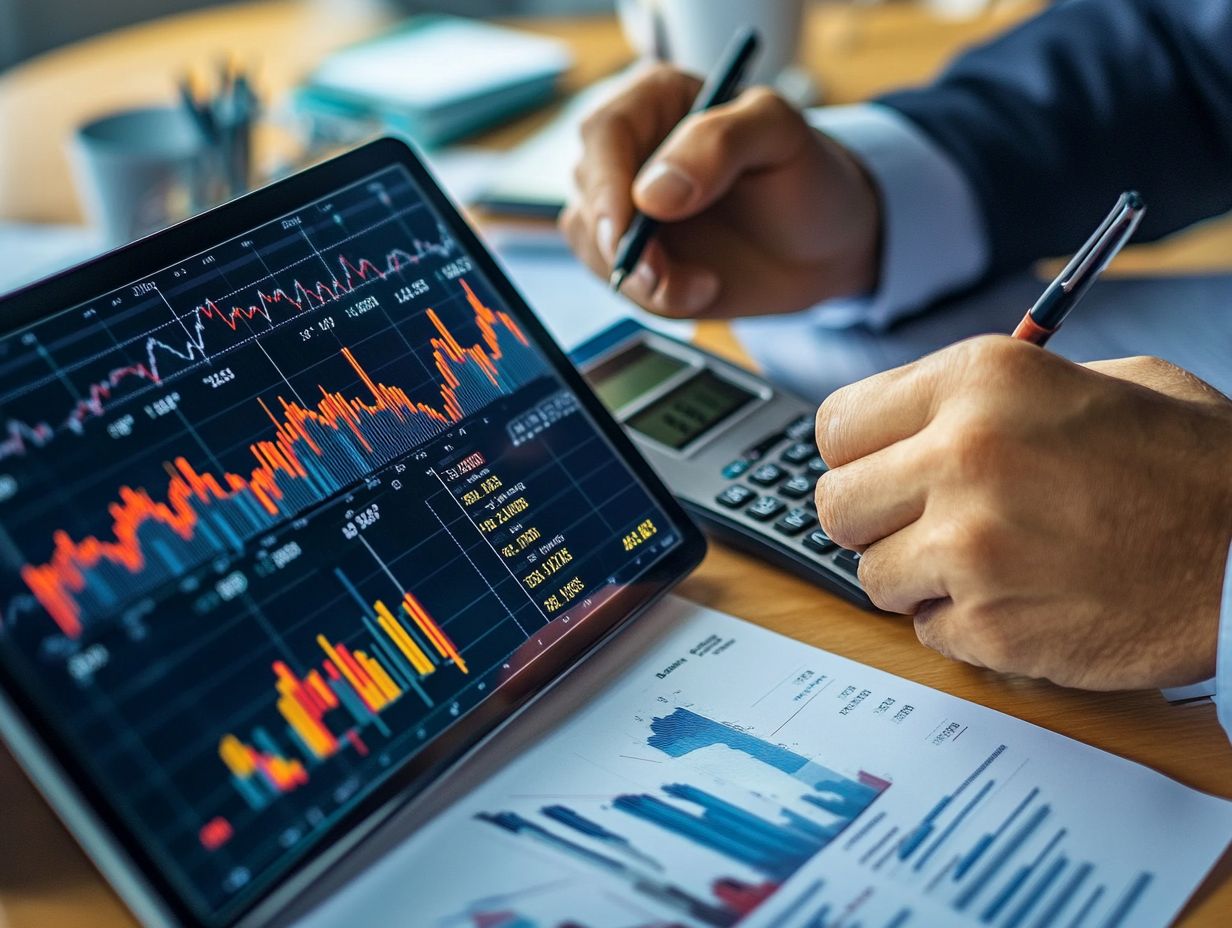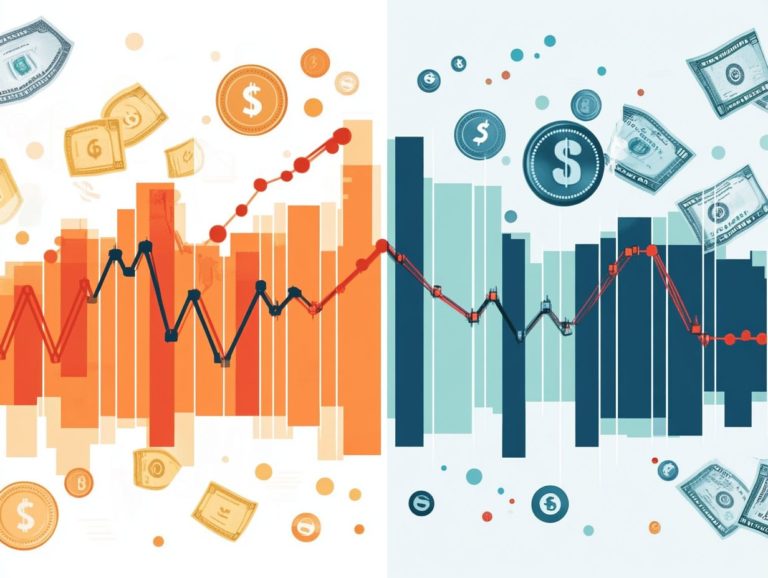7 Essential Risk Indicators for Investors
In the ever-evolving landscape of investing, grasping the concept of risk is vital for making informed decisions.
This article delves into seven essential risk indicators that you should be aware of, including market volatility, economic conditions, and geopolitical risks. By analyzing these factors, you can uncover valuable insights into potential challenges and opportunities that the market may present.
We will also explore how you can effectively identify, assess, and mitigate these risks, along with common pitfalls to avoid. Stay updated and boost your investment strategy now by uncovering the elements that can significantly impact your financial future.
Contents
- Key Takeaways:
- 1. Market Volatility
- 2. Economic Conditions
- 3. Company Performance
- 4. Industry Trends
- 5. Regulatory Changes
- 6. Political Instability
- 7. Geopolitical Risks
- What Are Risk Indicators and Why Are They Important for Investors?
- Frequently Asked Questions
- What are the 7 essential risk indicators for investors?
- How does volatility affect investors?
- What is liquidity and why is it important for investors?
- What is credit risk and how can it affect investors?
- How does geopolitical risk impact investments?
- What is concentration risk and why is it a crucial indicator for investors?
- What is fraud risk and how can investors protect themselves?
Key Takeaways:

Market volatility, economic conditions, and company performance are key risk indicators that investors should closely monitor. Regulatory changes, political instability, and geopolitical risks can significantly impact an investor’s portfolio and should not be overlooked. To accurately assess and mitigate risk, investors should consider a combination of quantitative and qualitative factors and continuously stay informed about potential risks.
1. Market Volatility
Market volatility represents fluctuations in asset prices, and you must handle these changes carefully, as they can significantly impact your investment strategies and the broader financial markets.
This volatility reflects economic conditions that require careful attention to reduce risks related to financial crime and compliance.
To truly understand this volatility, you’ll need to analyze various factors, including key economic indicators like inflation rates and unemployment figures, which often signal shifts in market dynamics.
Keep in mind that investor psychology plays a pivotal role here; people can quickly go from feeling positive to negative, leading to herd behavior that exacerbates price swings.
During turbulent periods, asset classes such as corporate bonds may come under heightened scrutiny, especially as interest rates fluctuate.
Rating agencies like Moody’s are your allies in this landscape. They assess risks by evaluating creditworthiness and market trends, providing insights that can shape your investment goals and strategies.
Their assessments help you weigh potential returns against associated risks, facilitating more well-considered choices.
2. Economic Conditions
Economic conditions are pivotal in shaping market risks, influencing both liquidity risk and country risk, which can have profound effects on your investments and the broader financial landscape especially in light of emerging political risks and global sanctions evasion strategies.
Key indicators like Gross Domestic Product (GDP), which is the total value of goods and services produced in a country, inflation rates, and employment levels act as vital benchmarks for gauging economic health. For example, if you notice a declining GDP, it may signal a recession, prompting you to reassess your investment portfolio.
On the flip side, strong employment rates typically indicate increased consumer spending, which can enhance market confidence. Significant geopolitical events, such as the Russia-Ukraine conflict, create uncertainty in the markets.
Behavioral economics suggests that this kind of instability can lead you to make irrational decisions, often resulting in market volatility as you seek to safeguard your assets or seize fleeting opportunities.
3. Company Performance
Company performance serves as a crucial indicator of financial health, influencing credit risk and demanding thorough risk assessment processes that prioritize transparency and exposure. This enables you to make informed investment decisions.
To effectively evaluate this performance, you can utilize various methods, including an analysis of key financial ratios like:
- Return on equity (ROE), which indicates efficient use of shareholders’ equity.
- Current ratio, which measures a company’s ability to pay short-term obligations.
- Debt-to-equity ratio, which assesses a company’s financial leverage.
Comprehensive earnings reports also provide valuable insights into profitability and operational efficiency. In this landscape, credit rating agencies like Moody’s play an essential role. They assess the creditworthiness of organizations, providing ratings that reflect the perceived risk associated with your investment choices.
The principles of corporate governance are also important. Strong governance can bolster your confidence as an investor by ensuring accountability and ethical decision-making, ultimately influencing stock prices and the long-term viability of your investments.
4. Industry Trends
Industry trends influence your investment strategies, affecting the risk categories you must navigate. Consider potential black swan events that could disrupt market integrity and change the financial landscape.
Recently, you may have noticed sectors like technology and healthcare undergoing rapid transformations. Innovations in artificial intelligence, telemedicine, and biotechnology propel these changes, unveiling new investment opportunities and presenting unique challenges.
For example, the unforeseen impact of the COVID-19 pandemic drastically altered consumer behavior. This underscores the necessity of adaptability within investment portfolios.
Assess how these trends influence not just immediate returns but also long-term viability. Ultimately, this prompts a reassessment of your risk management strategies in this unpredictable environment.
5. Regulatory Changes

Regulatory changes, such as the US Corporate Transparency Act and ATAD III, impact your compliance processes. You must adapt to new standards to avoid KYC (Know Your Customer) failures that could expose your business to financial crime risks.
These regulations impose stricter reporting requirements and highlight the need for transparency in financial operations. This drives you to develop more robust compliance frameworks.
To navigate this landscape, stay informed about new developments. Utilize training and resources to ensure your team understands the complexities involved.
Technology plays a pivotal role; automated solutions can streamline your compliance efforts. This allows you to monitor transactions efficiently and respond swiftly to regulatory changes. Implementing advanced analytics and machine learning can further enhance your strategies by identifying suspicious activities and strengthening your overall risk management approach.
6. Political Instability
Political instability creates significant country risk, leading to sanctions evasion and increasing the potential for financial crime. This can fundamentally affect your confidence as an investor and the overall stability of the market.
Events like the unrest in Ukraine and the military coup in Myanmar demonstrate how quickly political upheaval can transform the investment landscape. You may grapple with immediate financial implications and longer-term effects on market sentiments and regulatory frameworks.
Navigate this treacherous terrain with confidence by adopting a proactive risk management approach. Consider these strategies:
- Diversify your portfolio to include less volatile regions.
- Use hedging techniques to protect your investments.
- Stay updated on geopolitical developments.
This awareness enables you to make informed decisions, safeguarding your interests in an unpredictable environment.
7. Geopolitical Risks
Geopolitical risks encompass many factors that can significantly influence your investment and market risks.
These include the potential for sanctions evasion and the overall financial stability of regions grappling with political turmoil. Such elements can spark volatility in stock markets, disrupt supply chains, and alter currency values, creating a ripple effect throughout global financial systems.
Remain vigilant as you navigate these turbulent waters. Regularly assess the impact of trade wars, military conflicts, and diplomatic relations on your portfolio.
Incorporating scenario analysis and geopolitical indicators into your strategies offers valuable insights, enabling you to make well-informed decisions. By adopting a proactive approach to risk assessment, you can effectively safeguard your investments against unforeseen market shocks.
What Are Risk Indicators and Why Are They Important for Investors?
Risk indicators are critical tools for investors, offering vital insights into credit risk, liquidity risk, and overall market stability.
These factors significantly influence investor psychology. They help craft effective risk management strategies.
You ll find that these indicators include a variety of data points, such as:
- Numbers that show a company’s financial health, like debt-to-equity and current ratios
- Market data, including volatility indices and credit spreads
By diving into these metrics, you can identify potential pitfalls in your portfolio. This allows you to anticipate shifts in the market.
Grasping the importance of different types of risk indicators is essential. For example, financial ratios provide a snapshot of a company s health, while market data reflects broader economic trends.
These insights help you make informed decisions that align with your risk tolerance and objectives. This ensures you remain ahead in an ever-evolving financial landscape.
How Can Investors Identify and Analyze Risk Indicators?
Investors can identify and analyze risk indicators by employing a blend of qualitative and quantitative methods. This approach enables the development of robust investment strategies.
By evaluating market trends like stock volatility and economic indicators while also diving into detailed financial reports, you can uncover patterns that might signal potential risks.
Techniques such as scenario analysis and stress testing help anticipate adverse market conditions. This allows for a proactive approach to risk management.
These insights assist in refining investment decisions. They also play a crucial role in crafting strategies that mitigate risks, ensuring asset portfolios remain resilient amid uncertainty.
Ultimately, a comprehensive understanding of these indicators equips you to safeguard your assets while seizing growth opportunities.
What Are the Key Factors to Consider When Assessing Risk?

When assessing risk, it s essential to consider key factors, including market risks, diversification strategies, and overall risk exposure. This ensures alignment with investment goals.
Diversification plays a pivotal role in mitigating risk. By spreading investments across various asset classes, such as stocks, bonds, and real estate, you can reduce the potential impact of poor performance from a single investment.
If your portfolio leans heavily on technology stocks during a downturn, having investments in stable sectors, like utilities or consumer goods, can cushion your overall losses.
Finding the right balance between risk and return shapes your investment strategies and supports long-term financial objectives.
How Can Investors Mitigate Risk?
Investors can effectively mitigate risk through sound management techniques, such as diversifying portfolios and adapting investment strategies to the current market environment.
By actively engaging in hedging, you can safeguard against potential losses in volatile markets. Thoughtful asset allocation ensures investments are spread across various sectors and asset classes.
This approach protects you from downturns and opens the door to exciting growth opportunities. The importance of continuously monitoring market conditions cannot be overstated.
By staying informed and agile, you can swiftly recalibrate your strategies to address emerging operational risks. This proactive mindset enhances financial resilience and fosters sustainable growth over the long term.
Now is the time to apply these insights about risk indicators in your investment strategies. Take control of your financial future!
What Are the Common Mistakes Investors Make When Assessing Risk?
Common mistakes investors make when assessing risk often arise from cognitive biases and a limited grasp of market dynamics. This can result in flawed investment strategies and unnecessary exposure to investment fraud.
Take overconfidence, for instance. It s a prevalent issue that can lead you to underestimate risks and overestimate your predictive abilities in volatile markets. This mindset can culminate in poor investment decisions and significant financial losses.
Then there’s loss aversion the tendency to prioritize avoiding losses over acquiring equivalent gains. This can leave you paralyzed in your decision-making or push you toward overly conservative strategies.
By cultivating a deeper understanding of behavioral economics, you can embrace a more mindful investment approach. Education is key; recognizing these biases enables you to develop strategies that minimize emotional influences, ultimately paving the way for healthier financial outcomes.
How Can Investors Stay Informed About Potential Risks?
You can stay well-informed about potential risks by using different resources, such as financial news outlets, market analysis tools, and updates on regulatory changes that could influence your investment strategies and the broader financial landscape.
Actively engaging with these resources not only deepens your understanding of the dynamic market but also positions you to make more informed decisions. Subscribing to reputable financial publications offers you up-to-date analyses. Attending webinars creates interactive learning opportunities that enhance your knowledge.
Participating in investment forums opens doors for engaging discussions, allowing you to hear diverse perspectives and share your thoughts with fellow investors. Staying vigilant about emerging risks demands an ongoing commitment to education. Prioritize continuous learning in your investment journey to protect your investments today!
Frequently Asked Questions
What are the 7 essential risk indicators for investors?

The 7 essential risk indicators for investors are volatility, liquidity, credit risk, market risk, geopolitical risk, concentration risk, and fraud risk.
How does volatility affect investors?
Volatility refers to the amount of fluctuation in the value of an investment. High volatility can lead to significant gains or losses, making it a crucial risk indicator for investors to consider.
What is liquidity and why is it important for investors?
Liquidity refers to how easily an investment can be bought or sold without affecting its market price. Understanding liquidity can be a game changer for your investment strategy, especially when accessing funds in emergencies or changing market conditions.
What is credit risk and how can it affect investors?
Credit risk refers to the risk of default by a borrower. For investors, this can result in delayed or missed payments, or even the loss of the entire investment. It is important to assess credit risk before investing in any company or financial instrument.
How does geopolitical risk impact investments?
Geopolitical risk refers to the potential impact of political events, such as wars, trade disputes, or natural disasters, on investments. These events can cause sudden changes in the market and affect the value of investments.
What is concentration risk and why is it a crucial indicator for investors?
Concentration risk refers to having a significant portion of an investment portfolio in a single asset, sector, or geographical region. This increases the risk of losses if that asset or sector performs poorly. Diversifying investments can help mitigate concentration risk.
What is fraud risk and how can investors protect themselves?
Fraud risk refers to the potential of being scammed or misled by fraudulent activities, such as Ponzi schemes or fake investment opportunities. Investors can protect themselves by conducting thorough research and due diligence before investing. Be cautious of high-risk, high-return opportunities.
Stay updated on investment tips by subscribing to our newsletter!






